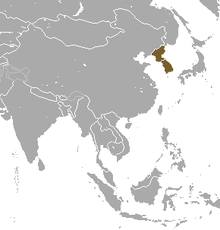Korean hare
| Korean hare[1] | |
|---|---|
| Scientific classification | |
| Kingdom: | Animalia |
| Phylum: | Chordata |
| Class: | Mammalia |
| Order: | Lagomorpha |
| Family: | Leporidae |
| Genus: | Lepus |
| Species: | L. coreanus |
| Binomial name | |
| Lepus coreanus Thomas, 1892 | |
 | |
| Korean hare range | |
The Korean hare (Lepus coreanus) is a species of hare found in the Korean Peninsula and adjoining parts of northeastern China. An adult Korean hare weighs 2.1–2.6 kilograms, and has a body length of 45–54 centimetres. The tail is typically 2–5 cm in length, and the ears are 7.6–8.3 cm long. The Korean hare inhabits diverse habitats within its range, from remote mountain forests to cultivated land. Fur colour varies slightly among individuals, but is generally some shade of liver brown.
Taxonomy
The Korean hare was first described by Thomas in 1892. Apart from the it, five other species of hare in the genus Lepus occur in eastern Asia, the Chinese hare (L. sinensis), the mountain hare (L. timidus), the Manchurian hare (L. mandschuricus), the Japanese hare (L. brachyurus) and the brown hare (L. capensis). In 1974, the Korean hare was considered to be a subspecies of L. brachyurus and in 1978, a sub-species of L. sinensis, however, study of mtDNA has now shown that the Korean hare is indeed a valid species, L coreanus.[3]
Distribution and habitat
The Korean hare is endemic to South Korea, North Korea and the Jilin Province in northeastern China. It is found on plains, in scrublands and in mountainous regions. Densities ranged from no individuals on coastal cultivated land to four individuals per square kilometre (0.4 square mile) in the hills and five per square kilometres in the mountains. A study in the Jirisan National Park in South Korea found that its abundance increased in proportion to the density of scrub cover in its habitat.[2]
Status
The IUCN, in its Red List of Threatened Species, lists the Korean hare as being of "Least Concern". This is because, although the population trend is unknown, this hare seems to be a common species without any specific identified threats. It has been reported as damaging barley crops in the foothills of South Gyeongsang Province, and ringing the bark and killing peach trees in South Jeolla Province, both in South Korea.[2]
See also
References
- ↑ Hoffman, R.S.; Smith, A.T. (2005). "Order Lagomorpha". In Wilson, D.E.; Reeder, D.M. Mammal Species of the World: A Taxonomic and Geographic Reference (3rd ed.). Johns Hopkins University Press. p. 198. ISBN 978-0-8018-8221-0. OCLC 62265494.
- 1 2 3 Smith, A. T.; Johnston, C. H. (2008). "Lepus coreanus". IUCN Red List of Threatened Species. Version 2013.1. International Union for Conservation of Nature. Retrieved 2013-09-06.
- ↑ Hung Sun Koh; Kyung Hee Jang (2010). "Genetic distinctness of the Korean hare, Lepus coreanus (Mammalia, Lagomorpha), revealed by nuclear thyroglobulin gene and mtDNA control region sequences". Biochemical Genetics. 48 (7–8): 706–710. doi:10.1007/s10528-010-9353-0.
